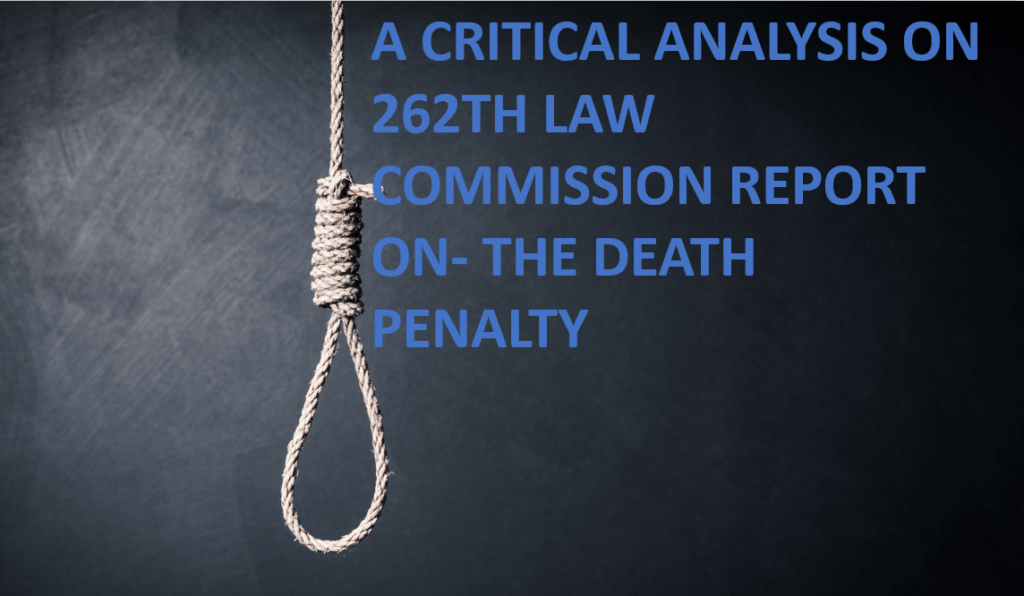
This article is written by Vivek Kumar of 1st Semester of Lloyd Law College, an intern under Legal Vidhiya
Abstract
First, the death penalty has been around for a really long time. In the past, it was more about payback, but now we try to make it fair. Still, it’s a big question if it’s the right thing to do. Some people think it’s okay because they believe it stops others from doing bad things. Others say it’s not right because we might make mistakes, and it’s not fair to take someone’s life by accident. Around the world, countries have different opinions. Some use the death penalty a lot, some don’t at all, and some are still deciding. It’s a mix of what people think is right based on their culture, religion, and government
Keywords
Ethics, morality, human rights, deterrent effect, justice, societal protection, global perspectives, political considerations, abolition, policymaking.
Introduction
The death penalty, also known as capital punishment, is a topic that makes people feel strongly one way or the other. It’s about deciding if it’s okay for the government to take someone’s life as a punishment for serious crimes. This issue has been around for a very long time, and it’s changed a lot over the years as societies have evolved. Some people think it’s necessary to keep society safe, while others say it’s just not right to take a person’s life, no matter what they did. In this discussion, we’ll look at the history of the death penalty, talk about why people have different opinions, and explore what this means on a global scale. Understanding these different views is important as we think about what kind of justice system we want.
History of death penalty in India
The history of the death penalty in India dates back to ancient times, where mentions of it can be found in some of the earliest legal codes, including texts like the Arthashastra. It’s crucial to recognize that the ways it was applied and the methods used have changed significantly throughout the centuries. Under British colonial rule, the death penalty became more common and standardized in India. The British authorities employed capital punishment for various offenses, such as murder, banditry (dacoity), and political crimes, viewing it as a means of deterrence and control. After gaining independence, India kept the death penalty as a legal punishment. The Indian Penal Code, established in 1860, continued to include provisions for the death penalty for different offenses. The history of the death penalty in post-independence India has seen periods where it was maintained and times when it was reconsidered. The Indian Constitution, in effect since 1950, allowed for the death penalty in exceptional cases. However, ongoing legal and public discussions have questioned its appropriateness and effectiveness as a deterrent to crime. High-profile cases have triggered public debates and calls for abolishing the death penalty. Despite these debates, the death penalty remains legal in India. Yet, there is a noticeable shift in recent years towards being more selective in its application and a trend indicating a reduction in its usage.
International trends
Around the world, countries have different opinions on the death penalty. Some are moving away from using it, while others still practice it. Many people and organizations globally think it’s a good idea to stop using the death penalty due to concerns about human rights and fairness. They believe it’s better to find other ways to punish serious crimes. In places likeEurope, many countries have already stopped using the death penalty. The United Nations, a big international group, has also said that there should be a pause in using the death penalty with the goal of getting rid of it altogether. However, some countries still use the death penalty, often for cultural or legal reasons. Despite this, there’s a growing agreement worldwide that we need to be very careful when using the death penalty. It’s important to make sure that the legal process is fair, and there’s a push to limit its use as much as possible. The conversation globally is leaning towards stopping the death penalty, focusing more on human rights and fairness in the justice system.
Penological justification for the Death Penalty
Deterrence: Some people believe that the threat of the death penalty stops others from committing serious crimes because they’re scared of the severe punishment.
Retribution: Others think that if someone does something really bad, they should get a punishment that matches the seriousness of their crime. It’s like saying, “You did something awful, so something equally serious should happen to you.”
Public Opinion and Moral Values Some argue that using the death penalty reflects what the majority of people in a society believe is right and wrong. It’s about following the values and feelings of the community.
Incapacitation: Another idea is that by giving the death penalty, we make sure a dangerous person can never harm others again. Life imprisonment might not be seen as enough to keep everyone safe.
Sentencing in capital offences
Some crimes are so bad that they can lead to the most serious punishment, which is the death penalty. When a person is found guilty of such a serious crime, the court has to decide what punishment they should get. Some people think the death penalty is the right punishment for the worst crimes, like planned murders or acts of terrorism. They believe it shows how serious these crimes are. Others worry that deciding who gets the death penalty might not always be fair. Factors like a person’s race or how much money they have can sometimes affect the decision. There’s also a big concern about making a mistake and punishing someone who is innocent, which is a really serious problem because you can’t undo it. So, people argue about whether the death penalty is a good idea or if it has too many problems.
Case laws
Chhannulal Verma v. the State of Chattisgarh (2019)[1]
In 2019, there was a case involving a person named Chhannulal Verma in the state of Chhattisgarh. The Sessions Court found him guilty of serious charges like murder, attempted murder, threatening to kill, and house trespass. As a result, he was given a life sentence, fines, and even a death penalty because the court believed the crime was exceptionally brutal and planned. The court thought the way Chhannulal Verma selected his victims showed that he had thought about the crime beforehand. Because of the extreme brutality throughout the whole incident, the court considered it to be an exceptionally rare case, and hence, they decided to give him the death penalty
Surendra koli v. state of up (2011)[2]
should have been given more time to present evidence that might lessen his punishment before the court decided on his sentence Surendra Koli v. State of UP (2011) was a shocking and tragic incident known as the Nithari case that happened in 2007. In this case, the bodies of children and adults were discovered at Mohinder Singh Pandher’s house in the village of Nithari in Noida. Upon further investigation, it was revealed that the girls’ bodies had been subjected to terrible crimes—rape, murder, and even cannibalism by Koli. He was found guilty of such horrific acts against fifteen girls and was initially given the death penalty due to the severity of the crimes. However, because of certain legal provisions related to plea bargaining, his punishment was later reduced to life imprisonment. The case stirred widespread shock and concern in India due to the gruesome nature of the crimes committed.
Manoharan v. State by Inspector of Police (2019)[3]
In the case of Manoharan versus the State, the Supreme Court of India was looking at the appeal of a person who had been given the death penalty for doing something really terrible—he raped and killed a young girl and also killed his own little brother. A lot of people were questioned in the trial to figure out what happened. The trial court decided that this person, called the appellant, was guilty of several serious charges, like planning the crime (Section 120-B), kidnapping (Section 364-A), rape (Section 376), and murder (Section 302), among others. He got a life sentence for the rape and a death sentence for the murder.
Law commission report on death penalty[4]
The Law Commission of India, led by Justice A.P. Shah, looked into the matter of the death penalty in India and presented its 262nd report on August 31, 2015. The Supreme Court had asked the Commission to do this after two specific cases in 2009 and 2013. It’s important to note that the Commission, in its 35th report in 1967, had earlier suggested keeping the death penalty in India. Also, in 1982, the Supreme Court, in the bachan singh case [5]said that the death penalty is okay but should only be used in the rarest of rare cases to make it fairer. However, the Commission realized that a lot has changed in India since the 35th report, and there are still concerns about how the death penalty is given out. They recognized that this is a sensitive topic, so they decided to carefully study the issue again to see if there should be any changes.Top of Form The Law Commission carefully studied the issue and found that the death penalty doesn’t deter crime any better than life imprisonment does. In fact, it doesn’t really achieve any of the important goals we want from a punishment. In 1973, this changed, and special reasons were required for imposing the death penalty. Then, in 1980, the Supreme Court made it even more restricted, saying that the death penalty should only be used in the rarest of rare cases. According to the Commission, this shift in approach indicates that it’s time for India to move away from the death penalty altogether. The Commission suggests that there’s no good reason to treat terrorism differently from other crimes when it comes to the death penalty. However, recognizing the concerns raised by lawmakers about national security, the Commission recommends taking the first step towards abolishing the death penalty for all offenses except those related to terrorism. In essence, the idea is to start moving away from the death penalty and limit its use, especially for crimes other than terrorism. The Law Commission is saying a few important things. First, they think it’s crucial for the government to set up good plans to help and support people who have suffered because of a crime. This is called a victim compensation scheme. They also want courts to use their power to give money to victims in certain cases. The Commission realizes that many victims and witnesses are scared and pressured by powerful people accused of crimes. So, they’re suggesting that there should be a plan to protect these witnesses and make sure they can speak up without fear. This is called a witness protection scheme. The Commission is also pointing out that our police system needs to get better. They’re saying that we need changes to make sure investigations and legal processes are more effective. These improvements are really important and should be a top priority according to the Law Commission.
Conclusion
Opinions about the death penalty differ widely. Some argue that it should be completely abolished because it might lead to mistakes, and once someone is executed, there’s no way to undo it. They also point out that it doesn’t necessarily prevent crime better than other punishments. On the other hand, there are those who believe in keeping the death penalty, thinking it serves as a strong deterrent for serious crimes and brings a sense of justice to victims and their families. Another perspective suggests a middle ground, proposing changes to make the use of the death penalty fairer and less prone to errors, like being more careful about when it’s applied and ensuring everyone gets a fair trial. Globally, more countries are moving away from using the death penalty, with human rights advocates emphasizing the importance of treating everyone fairly and upholding basic human rights. Ultimately, the debate on the death penalty revolves around questions of justice, morality, and the effectiveness of punishment.Top of FormTop of Form
[1] Chhannulal verma v. the state of chattisgarh(2019)
[2] Surender koli v. state of UP (2011)
[3] Manoharan vs state by inspector of police (2019)
[4] 262nd law commission report
[5] Bachan singh vs state of Punjab
Disclaimer: The materials provided herein are intended solely for informational purposes. Accessing or using the site or the materials does not establish an attorney-client relationship. The information presented on this site is not to be construed as legal or professional advice, and it should not be relied upon for such purposes or used as a substitute for advice from a licensed attorney in your state. Additionally, the viewpoint presented by the author is of a personal nature.




0 Comments